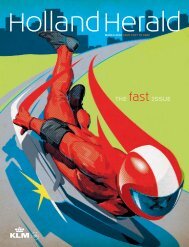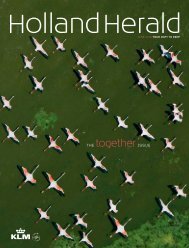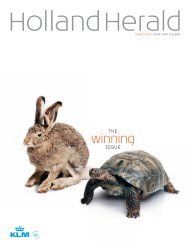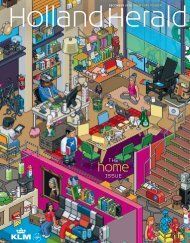february-2012
february-2012
february-2012
Create successful ePaper yourself
Turn your PDF publications into a flip-book with our unique Google optimized e-Paper software.
THIS PAGE<br />
Ashok Bhalotra<br />
and his<br />
Rotterdam office<br />
FACING PAGE<br />
The City of the<br />
Sun in<br />
Heerhugowaard<br />
the mayor asked if I had sunstroke<br />
aft er I’d made my presentation. In India<br />
too, I had to work hard to convince<br />
people about sustainable energy. How<br />
did I do it? Not by talking about climate<br />
change, nobody understands that.<br />
Instead, I reminded people of how as<br />
kids they started a fi re using a<br />
magnifying glass — everyone’s done<br />
that, and it gets you thinking about the<br />
power of the sun and how it can be used<br />
to heat and cool a house. You have to<br />
appeal to people’s imagination.”<br />
Imagination is certainly needed to<br />
understand the rapid urbanisation of the<br />
human race. In 1800, only 2% of us lived<br />
in cities. Now, more than half of us do,<br />
and that percentage is rising steeply.<br />
Th e World Bank estimates that<br />
almost 200,000 people move to the city<br />
every day. In developing countries, 60<br />
million new urbanites arrive every year,<br />
and in the next decade, many African<br />
and Asian cities will double in size.<br />
By 2015, there will be 23 cities on<br />
42 Holland Herald<br />
earth with more than 10 million people,<br />
and 19 will be in developing nations.<br />
What all this might mean is the<br />
subject of a dramatic growth in urban<br />
studies and in projects ranging from the<br />
UN’s Habitat Programme to the LSE’s<br />
(London School of Economics) Urban<br />
Age think-tank.<br />
But it hasn’t always been this way,<br />
says Bhalotra. “Urban planning has been<br />
historically isolated from the political,<br />
economic and social agenda,” he says.<br />
“It needs to be connected, but there<br />
has been a strong anti-city sentiment,<br />
people were stuck in some kind of<br />
pastoral dream.”<br />
As Europe industrialised in the 18th<br />
century, the expanding city was seen as<br />
debased. Th e philosopher Rousseau<br />
summed it up when he gravely<br />
announced, “Cities are the abyss of the<br />
human species.”<br />
Th e industrialists who made their<br />
money from urban factories were quick<br />
to move out of town to country estates,<br />
while their workers were left to languish<br />
in inner-city slums.<br />
By the 20th century, planners were in<br />
a form of mass urban denial, building<br />
‘garden cities’ and suburbs that tried to<br />
replicate some imagined village ideal,<br />
partly fuelled by the rapid rise of<br />
personal car ownership.<br />
But harsh economic realities are<br />
ending the reign of suburbia, as<br />
Canadian urban planner Ken Greenberg<br />
confi rms in his book, Walking Home:<br />
Th e Life and Lessons of a City Builder.<br />
“Th e inevitable rise of the oil price —<br />
20% here in Canada last year — is a<br />
game changer,” he says.<br />
“Th ere’s a huge realisation that we’ve<br />
massively underinvested in public<br />
transit, and cities everywhere are being<br />
equipped for bicycles.”<br />
Th ere’s a growing awareness that<br />
future city planning departments will no<br />
longer be able to aff ord to give the traffi c<br />
engineer free rein.<br />
“Public transport has to be there from<br />
the beginning,” says Bhalotra, whose

















